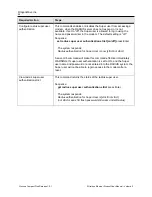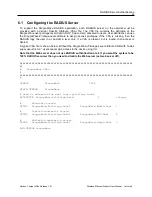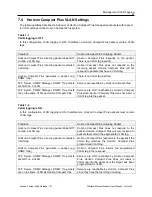
Quality of Service (QoS)
35
Horizon Compact Plus Release 1.0.1
Wireless Ethernet Product User Manual
– Volume 2
The user sets the CIR and the weight (
set cos wfq weight [w1 w2 w3 w4 w5 w6 w7 w8]
for each queue
and the scheduler processes each queue based on those parameters.
Up to four expedite queues (Q8 to Q5) can be configured (see Section 8.5.4).
The queues are serviced in a round-robin fashion (in order Q8, Q7, Q6, Q5, Q4, Q3, Q2, Q1) except for
the expedite queue(s) (if enabled) which are serviced with highest priority.
Any queue can utilize any excess bandwidth, proportional to its assigned weight, provided all queues with
pending packets have their CIR met.
When all the queues meet their CIR, the remaining bandwidth is distributed amongst the queues,
proportional to their weights.
Example:
Each queue, Q1 to Q8, is configured with a weight of w1, w2, w3, w4, w5, w6, w7 and w8
respectively (values 0
– 64). Assuming a total bandwidth capability of 200 Mbps (system current
speed), and the CIR for each queue is set to 10% (20 Mbps), this means that there is a surplus
bandwidth of 200
– 80 = 120 Mbps if all queues are meeting their CIR. This surplus bandwidth is
made available to all queues in a proportion determined by the weight assigned to each queue, if
they need it.
The surplus bandwidth share of queues Q1 to Q8 shall be:
Q1 = 120 * w1 / (w1+w2+w3+w4+w5+w6+w7+w8)
Q2 = 120 * w2 / (w1+w2+w3+w4+w5+w6+w7+w8)
Q3 = 120 * w3 / (w1+w2+w3+w4+w5+w6+w7+w8
Q4 = 120 * w4 / (w1+w2+w3+w4+w5+w6+w7+w8)
Q5 = 120 * w5 / (w1+w2+w3+w4+w5+w6+w7+w8)
Q6 = 120 * w6 / (w1+w2+w3+w4+w5+w6+w7+w8)
Q7 = 120 * w7 / (w1+w2+w3+w4+w5+w6+w7+w8)
Q8 = 120 * w8 / (w1+w2+w3+w4+w5+w6+w7+w8)
If Q1 does not have any traffic at a given time then the surplus bandwidth will increase to 120 +
20 = 140 Mbps. The surplus bandwidth share will now be distributed amongst the remaining
queues as follows:
Q2 = 140 * w2 / (w2+w3+w4+w5+w6+w7+w8)
Q3 = 140 * w3 / (w2+w3+w4+w5+w6+w7+w8
Q4 = 140 * w4 / (w2+w3+w4+w5+w6+w7+w8)
Q5 = 140 * w5 / (w2+w3+w4+w5+w6+w7+w8)
Q6 = 140 * w6 / (w2+w3+w4+w5+w6+w7+w8)
Q7 = 140 * w7 / (w2+w3+w4+w5+w6+w7+w8)
Q8 = 140 * w8 / (w2+w3+w4+w5+w6+w7+w8)
The benefits of WFQ include :
•
the queues are serviced in a fair way
•
bandwidth is not wasted when system is not congested.
•
CIR to queues is guaranteed.
•
The expedite queue, if enabled, will have the highest scheduling priority until the CIR
is met.
The peak information rate (PIR) of each queue is the same as the configured system current speed.






























